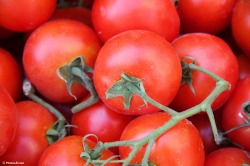
JULY in the garden:
• Plant beets and turnips for fall harvest.
• Thin out plants and fertilize.
• Fertilize potatoes with nitrogen.
• Watch watering on tomatoes! Even deep watering is better than frequent shallow watering to avoid blossom end rot.
• Irrigate at ground level rather than over head spray to avoid diseases.
• Keep looking for any signs of pests. Use insecticides only as necessary.
• Stake tomatoes if you haven’t already.
• Remove suckers and pinch back tomatoes as necessary.
This was from Glover Nursery’s website; see it for a month-by-month checklist.
Remember that you can also plant shorter-season crops; the seed envelope will tell you how many days until harvest for that variety. The official information for our area (data from Riverton) is that the earliest-ever fall freeze was Sept. 13, average date is Sept. 24, and latest was Oct. 4. So worst-case scenario is 58 frost-free days remaining, best-case is 80 days, plus whatever length you can extend your growing season by covering your garden with a sheet or blanket for those first frosts.
Now, for that fruit that some of you have coming out your ears- our favorite way to eat it is ‘Fruit Leather’.
Here are two samples of how much to use:
Apricot leather:
1 c. apricot puree (1 ½ c. pitted apricots)
1 Tbsp. lemon juice
Around 3 Tbsp.* sugar or honey
*2023 update- over the last several years I've reduced the sugar and lemon in this. 1 Tbsp. sugar/honey for every 1 Tbsp. lemon juice is plenty. I've even dropped it to 1 Tbsp. each per quart of puree, and it tastes delicious. It does sometimes brown more though.
Cherry leather:
1 c. cherry puree (1 ½ c. pitted cherries- or use the food mill for this one)
1 Tbsp. lemon juice
Dry until there are no more sticky spots, roll up and store in an airtight jar. We’re still eating leather made two summers ago, it’s holding up fine.
The best leather is made with overripe fruit, too, which is helpful! Basically, you puree or mash fruit, or send it through a food mill, sweeten it to taste, then dry it. You can sweeten it with concentrated fruit juice, or with sugar, or honey. We like it best with sugar because that way the fruit leather crystallizes over time, rather than getting tougher. You can also add a little lemon juice to keep the leather from turning brown as much.
Whatever you’re going to dry it on/in needs sprayed with Pam or oiled first. Trust me, you don’t want to forget that step. Leather is no fun to chip off of trays! Pour about a ¼” layer, and put it someplace to dry. It’ll be done in about 24 hours in a dehydrator. You can also dry it on cookie sheets in your oven (lowest setting, door slightly ajar for air circulation), or in a car parked outside on a hot day.
A good article on drying is at http://www.backwoodshome.com/articles/shaffer58.html
 RSS Feed
RSS Feed